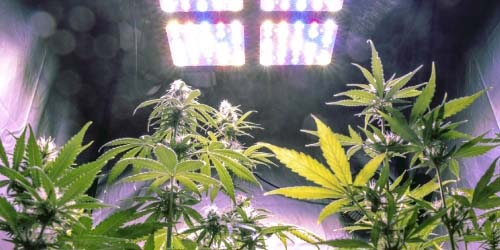
Are you going to grow indoor weed for the first time? Difficult to find a good manual? We know you don't feel like reading a huge book, that's why we've put all the basics in a short and concise article. Take a moment to read this short manual for beginners. After that you'll know exactly what you need to do to grow top quality indoor weed. Without any problems!
In dit artikel:
- Legislation & Safety
- Growing weed indoors: What does a weed plant need?
- Growing weed indoors without lamps
- The right cannabis seeds
- Growing schedule & Height of the grow lamp
- Germinating Cannabis Seeds
- Sowing weed & Seedlings
- The Growth phase of the Weed plant when growing indoors
- The Flowering phase of the Weed plant when growing indoors
- Leaf problems and Diseases
- When should I harvest the weed?
- Cutting, Drying & Curating weed
- Other questions about growing weed indoors
Legislation & Safety
First we want to protect you from the dangers of growing weed indoors. When working with grow lights and other equipment it is very important that you comply with safety. Grow lights can get hot and there is a fire hazard lurking. In addition, you don't want to cause a disturbance to your surroundings. Take this seriously and make sure your grow room is 100% fire safe before you start.
Watch out! Do you live in a (social) rental home? Then different rules often apply. Most leases state that growing cannabis is strictly prohibited. Are you doing it anyway? In the worst case, you can be evicted from your home, receive a hefty fine and get a criminal record.
Growing Weed Indoors: What does a weed plant need?
If you are going to grow weed indoors, you have to take into account five basic needs of weed plants:
- Light. Weed plants need light to grow and flower. Normally the sun provides enough light, but because you're going to grow in a grow room you'll need another light source. Artificial light from grow lights is necessary for a healthy indoor grow. Growing without lamps is almost impossible. Fluorescent and low-energy light bulbs are possible, but the yield is considerably lower.It’s a lot better to choose HID / HPS- or LED grow lamps. The biggest difference is in the wattage of the lamps (the higher, the better) and the different spectra. The need for light also varies with weed plants. For example, the need for daylight is greater during growth and the plant needs more sleep during flowering. That's why you need a light or growing schedule. More about this later.
- Darkness. So a weed plant also needs a night's sleep. A weed plant can only sleep when it's completely dark. It is therefore necessary that your growing space is dark when the light goes out.
- Air. A weed plant absorbs two substances from the air. The carbon dioxide goes through the leaves and oxygen through the roots. Although the first is automatic, the second is often a problem for weed growers. This problem is caused by the fact that the soil is too compact (mashed) or that the pot in which the cannabis plant is placed has no drainage. Drainage allows the excess water to drain away. Do you want to plant weed in the pot? Drill a number of holes in and around the bottom of a plastic pot. This will allow the excess water to drain away and provide the roots with oxygen.
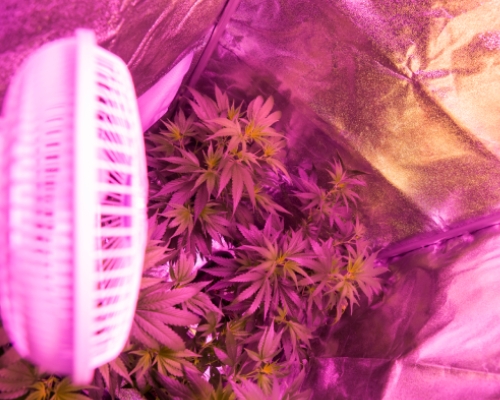
Fresh air and air circulation is very important.
- Water. Because it doesn't rain like in outdoor growing, you have to water weed plants yourself. Give the right amount of water that if you stick your thumb in the soil until the phalanx, the soil has to stick to your thumb. If it doesn't feel moist, then give more water. If not, you need to wait a little longer.
- Nutrition. Weed plants need different nutrients. Suitable potting soil or garden soil often already contain fertilizers. However, this is often not enough to provide your weed plant with essential nutrients during the entire growing process. That's why it is necessary to provide extra nutrients.
You usually add plant nutrition to the water you give to your plants. Which nutrition and how much you should give, we explain further on in this article. Or check the extensive explanation about plant nutrition in weed plants.
pH-value
The water you give to your weed plants must have a favorable pH value. The acidity of the water and the medium is important because otherwise nutrients will not or not fully be absorbed. Make sure that the (nutrient) water has a pH value between 5.8 and 6.3. You can adjust the pH-value downwards with pH minus from Plagron. Upward adjustment is not necessary in actual practice.
Beginning growers can choose to leave the pH value for what it is. Even without a favourable pH value your cannabis plants will grow and flower. Checking the pH value is recommended for the best results.
Growing Weed Indoor Without Lamps
Many beginning growers are experimenting with growing indoor weed without lamps. Theoretically, it is possible to put a weed plant by a window without artificial light. However, do not expect a big yield or high quality weed. Your plant simply doesn't get enough light to grow and flower properly. Factors such as the place where you put the weed plant, the type of weed seed and especially the moment when you are going to grow are also very important when growing without lights.
The Right Cannabis Seeds
You can buy all kinds of cannabis seeds. Our tip: use the handy filters from our online seedshop. For beginners, our advice is to choose auto flower seeds, or at least choose weed seeds with beginner-level difficulty.
Autoflower seeds are easy to grow because they automatically start flowering after a few weeks in the growth phase. You don't necessarily have to consider a light or growth schedule (though it is recommended) and the total duration of the growth is much shorter. With 'normal' photoperiod weed species a cultivation can take up to 6 months. With auto flowering seeds you can limit this to 8 - 15 weeks.
Another important point to consider when choosing weed seeds for indoor growing is the size of the plant. Sativa weed plants are usually taller than indica weed plants, which grow shorter and bushier. Furthermore, the maximum height varies enormously from strain to strain. Do you have limited space in your growing space? Then take a good look at the height of the cannabis plant when selecting your cannabis seeds.
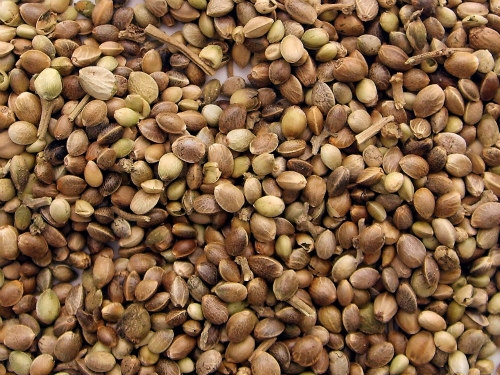
Growing schedule & Height of the Grow lamp
The need for light for weed plants varies per phase of cultivation. In the growing phase a cannabis plant needs at least 14 hours of light to grow. However, most growers use a light schedule of 18 hours of light and 6 hours of darkness during the growth phase. The so called 18/6 schedule.
A photoperiod weed plant needs at least 10 hours of darkness to start flowering. But for a prosperous flowering you choose a light scheme of 12 hours of light and 12 hours of darkness. The so called 12/12 scheme. When it's time to move from the growth phase to the flowering phase, you need to change the settings of your grow light.
Auto flowering weed plants will automatically switch to the flowering phase. You don't necessarily need different light schemes for the different phases. So you can put auto flowers on 24 hours of light for the rest of their lives. But we don't recommend that. Although auto flowers then grow and bloom faster, they are not stronger. The resting period they get at night contributes to strengthening the fibers. This allows your ladies to carry the flowers without drooping. However, we advise you to stick to the schedules above when growing auto flowers because this will give you the best results.
Set your grow light before you start growing. This will also help you determine how long your weed plant will grow and flower. Information about the length of the flowering period can be found in the product information of each weed seed.
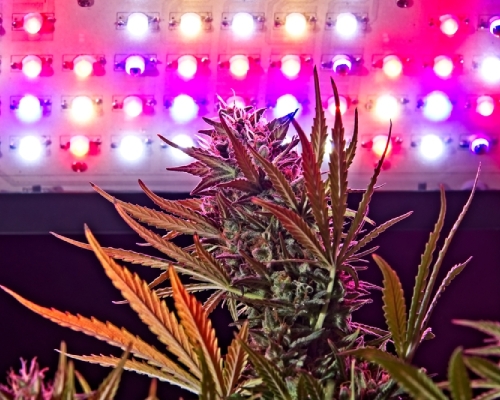
Height of the grow lamp
Grow lights should not hang too close to your weed plants. This has to do with the heat of the lamps or the intensity of the light. Too low and therefore too close to your buds is disastrous for the plant and it can damage your leaves and/or buds. Too high is a waste of the power of the light and this can cause a weed plant to stretch. When a cannabis plant doesn't get enough light it will start looking for the light. She does this by stretching which creates more space between the nodes (side branches). Therefore it's not a good idea to grow weed on the windowsill. That is why you should choose the right lamp height.
What is the right height of a grow light? With HID or HPS grow lights the height is easy to determine. The rule is that you maintain 10% of the wattage of the lamp in centimeters. So with a 600 watt lamp you hang the lamp 60 cm above your plants. With LED grow lights, the height of the grow light depends on several factors such as the wattage, the spectrum you use and a possible lens. Ask the seller or manufacturer of the grow light for an indication of the lamp height and keep a close eye on your plants.
Germinating weed seeds
Germinating weed seeds is not difficult. Place the seeds between the cotton pads in our germination tray and wet the pads well. Within two to five days the root is long enough to plant them. There are many articles written about the germination of cannabis seeds. Also by us. Do you want all the tips listed? Check out these articles:
- Germinating cannabis seeds with wads and Dutch-Headshop tray
- Help! My Weed Seeds Are Not Germinating
- Germinating Cannabis Seeds
- Sprout cannabis seeds like a pro!
Sowing weed & Seedlings
A weed plant needs as much space as possible. If you plant weed in a pot, choose the largest pot possible. The bigger the pot, the better for the plant. The minimum pot size is 12 liters per plant. Fill the pot with loose soil like standard potting soil. Do not mash the soil and make sure there is drainage through holes at the bottom of the pot. Put your pot straight under the grow light. By the way, choose a pot made of fabric or plastic and certainly not a stone pot. Stone pots are less suitable for growing weed because of the limited drainage and airflow. In plastic pots you can easily drill holes to increase both.
Master tip for standard potting soil: make your soil richer in fungi and bacteria with one of our soil enhancers. Place the germinated seed with the root down about an inch deep in the middle of the new soil. Cover lightly. Immediately give a little water and be careful not to wash away the soil. Better yet: you can choose to grow your germinated seed first in a spongepot. In this phase you can put your plant under the grow lamp. Pay attention to the height and preferably do not place in direct sunlight. If you don't give the seedling enough light, it will become unnecessarily long because the poor plant will start looking for light (stretching). By the way, keep the soil moist, but not soaking wet. We call such a young plant a seedling until it develops a few recognizable weed leaves.
Feeding: do not feed you plant is this phase.
The Growth phase of the Weed plant when growing weed indoors
A plant enters the growth phase (also called vegetative phase) when it is no longer a seedling. It is no longer a seedling when the first full leaf is formed.
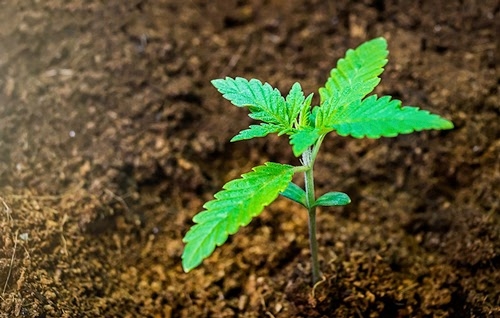
The first full leaf is shown.
Nutrition: When your weed plant has reached the growth phase, you can start feeding it. Choose growth nutrient and possibly a root stimulator. All types of plant nutrition that you can use during growth can be found on the . It is important that you add the right amount of plant nutrition to the water you give to your plants. For the correct amount, check the information on the bottle or look for a growing schedule from the manufacturer.
The growth phase after the seedling phase often takes only 1 to 3 weeks for auto flowering plants. With photoperiod weed plants this can vary enormously. You can also use your light scheme to control how tall the plant will grow.
The Flowering phase of the weed plant when growing weed indoors
After the growth phase comes the flowering phase. The moment when the weed plant starts making flowers (buds). In auto flower plants this is done automatically, as described earlier in the section on growing schedules. Photoperiod cannabis plants, on the other hand, need at least 10 hours of darkness to start flowering. You can regulate this by means of your light scheme. Often a 12/12 schedule is used to make sure the plants get enough rest.
»You can find all information about light schedules and spectra (light colour) in this blog.
When the weed plant enters the flowering phase, it often continues to grow for a while. Especially with sativa cannabis plants, the growth spurt can be enormous. It can sometimes grow up to twice as big. Keep this in mind and regularly check the lamp height!
Nutrition: When your weed plant has reached the flowering phase, you can start feeding it flowering nutrition. Choose flowering nutrition and possibly a flowering stimulator or PK booster. All kinds of plant nutrients you can use during flowering can be found on the special page for flowering nutrition. Just like in the growth phase, it is important that you add the right amount of plant nutrition to the water you give your plants. Consult the information on the bottle or a growing schedule from the manufacturer.
Leaf problems and diseases when growing indoors
Although the chance of leaf problems and diseases is higher when growing outdoors, you have to be careful with indoor weed as well. Bugs, diseases and shortages are just as likely to occur. That's why we would like to draw your attention to perhaps the most important rule in weed growing: look at your weed plants regularly and attentively. This is the only way to recognize problems or shortages in time and do something about them before it's too late. Do you notice that something is wrong with your plants? Check part 2 & 3 of the leaf problems blog series.
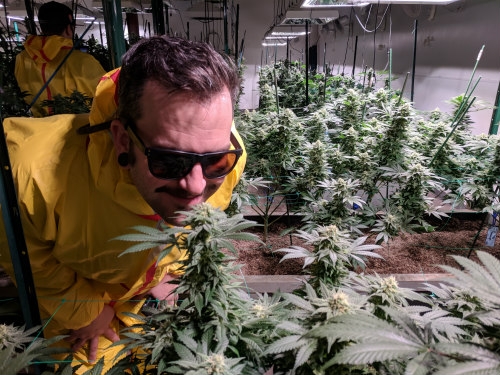
Regularly and carefully look at your weed to prevent problems.
When should I harvest the weed?
Weed is ready for harvest when the trichomes (resin glands) are predominantly milky white. In the picture below you see a top of a weed plant in the final stage of flowering. Numbers 1 to 4 show different balls of resin that are made by these resin glands. At number 1 it is too early to harvest. The resin is clearly transparent here. If most of the trichomes look like number 2, then it's time to harvest. It doesn't matter if a few balls start to turn amber like number 3. But don't wait until most of the trichomes have this colour. In simple words: your weed won't work as well then. If your weed starts to get brown like number 4, you are too late with harvesting. Of course you see all these colours at the same time on your weed plant - it's one picture after all. Again, the trick is to harvest when most of it is milky white (as number 2).
Trichomes are almost invisible to the naked eye. The best way to view the trichomes, is with a special weed microscope.
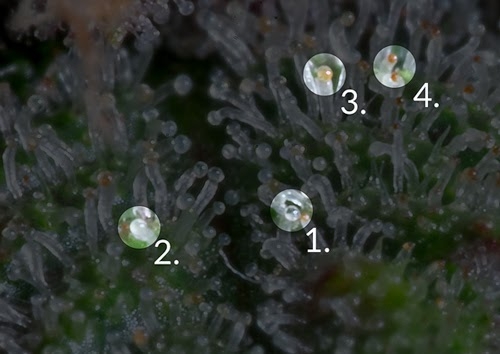
Trichomes in different stages.
What trichomes are and how to follow this process can be read in this extensive blog: How and when harvesting cannabis?
Cutting, drying and curating weed
When the weed is ready to harvest, you can start cutting and drying. Cutting weed is a time consuming job and everyone does it their own way. We recommend that you first cut away the bracts (large leaves). Then you take a branch and cut away the small leaves between the buds (sugar leaves). Then hang the branches and the buds in a dark space. You can also choose to cut all the buds off the branches and let them dry in a special drying net. Make sure that the buds do not touch each other, a temperature around 21 degrees Celsius and a favorable humidity of around 50%. The entire drying process takes about 1 to 3 weeks. For more information about cutting and drying weed, check out the extensive blog.
Drying cannabis is necessary! Wet (or actually fresh) weed is not usable. As soon as you light it, it goes out again. It also contains a substance that makes your weed taste bitter and dirty. By drying your weed you kill two birds with one stone. Moisture and bitter taste go away! Drying takes 8 to 20 days depending on the method and your weed will lose 65 to 80% weight in moisture. After drying you put the weed tips in closed jars with a bag that keeps the moisture percentage exactly at the right level. This last step is called curating and makes sure your weed gets the right structure and taste you're used to from weed from the coffeeshop.
Other questions about growing weed indoors
Have you read this manual on weed growing for beginners well and carefully? Then you are informed about everything you need to know to grow indoor weed. Would you like to know more about a certain subject? For each topic in this blog you can click through to more detailed information. Still can't figure it out? Our customer service is available five days a week to answer all your questions about growing weed.